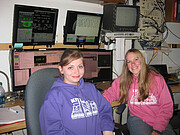Astronomers at the National Observatory Continue to Watch Sn 2014J
19 February 2014
The astronomical community was very excited by the appearance of a supernova in a relatively nearby galaxy in late January 2014. Observations of this supernova, located in the galaxy M 82, and referred to as SN 2014J revealed that it is a type Ia. These occur in a binary star system composed of a dense white dwarf star and a companion star, either another white dwarf or a bloated red giant star. These supernovae are especially interesting because they provide one of the best ways to measure distances to faint galaxies, and therefore calibrate the expansion of the universe. At Kitt Peak National Observatory (KPNO), two different teams have been observing SN 2014J.
At the Mayall 4-meter telescope on KPNO Dr. Ginger Bryngelson (Francis Marion University) and Dina Drozdov (Clemson University) were serendipitously engaged in a program to observe the slow fading of other previously known Ia supernovae when SN 2014J was first spotted, and immediately added this one to their program. As Ms. Drozdov said,” Since this one is so nearby, we will be able to monitor it for much longer past its explosion than others. It will become one of the most widely-studied in history.”
This team was using an infrared camera, the Florida Multi-Object Imaging Near-Infrared Grism Observational Spectrometer (known as FLAMINGOS). They were one of the few teams to take infrared spectra of SN 2014J. As it happened this was the last time that FLAMINGOS will be available on the telescope. Dr. Bryngelson commented, “We will miss FLAMINGOS because of its ability to switch back and forth between infrared imaging and spectra, but we will be able to use other instruments on the 4-meter or the WIYN 3.5 meter.”
By observing type Ia supernovae, they are exploring how the explosions occur by seeking to understand how much energy is released in different parts of the spectrum, and how this changes with time. As the ejecta from the explosion spreads out, it becomes easier to see directly into the central region. One of the other supernovae they were observing that night was over 600 days post explosion. They are also looking for what is termed a light echo, which occurs when light from the explosion is reflected off nearby intervening dust. Because the path that this light takes is longer than the direct rays that we see, the light echo is delayed in reaching us.
At the WIYN 3.5 meter telescope on Kitt Peak, WIYN and NOAO staff astronomers quickly designed an observing program to observe the supernova during twilight, when it would not interfere with already scheduled observations. The accompanying image shows SN2014J as it was observed on January 28, a few days before reaching maximum brightness. The observations are taking advantage of WIYN’s newest camera, the One Degree Imager (or ODI). The team is excited to be able to follow the fading light of this supernova during the months ahead using a telescope with as much light gathering power, and image resolution as the WIYN telescope. As Dr. Daniel Harbeck, WIYN scientist, said ”The advantage of the ODI camera is that not only can we observe the supernova at its peak brightness, something that not all large telescopes can do, but we will be able to follow it for a very long time as it fades.” The galaxy M 82 is particularly dusty, so observing the supernova through multiple different spectral filters enables astronomers to learn about both the explosion and the intervening interstellar dust.
More information
The ODI camera is funded by the WIYN partners, and the National Science Foundation, through its Telescope System Instrumentation Program. The WIYN partners are University of Wisconsin, Indiana University, Yale University, and the National Optical Astronomy Observatory (NOAO). KPNO is a division of the National Optical Astronomy Observatory, which is operated by the Association of Universities for Research in Astronomy Inc. (AURA) under a cooperative agreement with the National Science Foundation.
Contacts
Dr. Ginger Bryngelson
Physics & Astronomy Francis Marion University
Tel: 843-661-1553
Email: gbryngelson@fmarion.edu
Dr. Daniel Harbeck
WIYN Observatory
950 N Cherry Ave, Tucson AZ 85719, USA
Email: harbeck@noao.edu
About the Release
| Release No.: | noao1401 |
| Legacy ID: | NOAO 14-01 |
| Name: | SN 2014J |
| Facility: | Nicholas U. Mayall 4-meter Telescope, WIYN 3.5-meter Telescope |
| Instruments: | FLAMINGOS, ODI |






